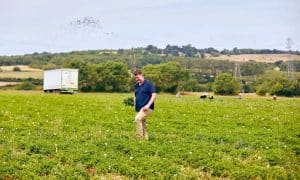The parsley and coriander grown by Joe Cottingham bring a hit of freshness to some of Charlie Bigham’s most popular ready-to-cook dishes. Sophie Goddard hears about the blood, sweat and tears that go into growing herbs.

Joe Cottingham’s day begins hours before most of us are even considering pressing snooze.
“Often it starts at 4am to ensure it’s as cool as possible when we begin harvesting,” says Cottingham, whose huge range of crops includes basil, beef tomatoes and baby courgettes.
A typical day for him might involve checking how planting, irrigation and harvesting are going, managing the packaging and distribution operation and working with retailers.
Cottingham, who has been in farming for nearly 25 years, is a director at the Watts Farms Group, which operates on eight sites across Kent and Essex.
Growing more than 100 varieties of vegetables, fruits and herbs, the farms have customers that range from supermarkets, hotels and restaurants to people living locally. And, for the past six years, Cottingham and his team have been responsible for growing the fresh herbs that go into some of the most popular ready-to-cook meals made by Charlie Bigham’s, elevating them from tasty to terrific.
“We grow a full range of herbs here – flat parsley, curly parsley, coriander, dill, mint, chives, thyme, rosemary, sage and basil,” says Cottingham. “And we supply our fresh coriander and flat parsley to the team at Charlie Bigham’s.” The herbs are destined for recipes such as the curries and the fish pies.
“Careful use of fresh herbs makes so much difference,” says Charlie Bigham, the founder of the food empire that bears his name. “Herbs give a dish that zing of freshness and make it look that bit more alluring.”
Watts Farms’ locations in some of the UK’s warmest spots mean that parsley can be grown for most of the year, maximising freshness and minimising the environmental impact of food miles as buyers don’t need to source from overseas.
Herbs are harvested daily and delivered to Charlie Bigham’s kitchen near Wells, in Somerset, the next morning. There, they are washed and chopped by a specially trained parsley team using bespoke (read: razor-sharp!) equipment.
This freshness is key, says Bigham. “There are certain herbs that can only be used fresh. And for me, parsley is at the top of that list. Should you have one of those jars of dried parsley at home I suggest you use up what you’ve got and don’t buy it again!”
What’s Cottingham’s secret to ensuring that the herbs he harvests measure up in the taste stakes? “We grow many varieties and have done a lot of trial work on finding the right ones for the right farms in the right weather conditions. A variety we use in spring would be different to a variety we use now, for example,” he says. “It means we grow our herbs in small batches and each year we assess them to ensure we have the most suitable varieties.”
But it’s not just suitability for the growing environment that matters, he says. “Everything is ultimately driven by taste and flavour, as well as how much life we can get from the plant postharvest – we want to keep our plants as fresh as we can.”
It figures then that Cottingham has become something of an expert when it comes to recognising each herb’s specific flavours. “When we’re selecting flavours, we’re looking for that distinctive coriander or flat parsley taste, but without it being too concentrated or strong. While it’s hard to overuse fresh herbs, there’s often a soapiness with coriander, for example, that can easily become overpowering or too floral. So we’re looking for flavours that leave their mark on the dishes, without overpowering them.”
Close working relationships with customers such as Charlie Bigham’s make the process an enjoyable and successful one. “We have a great relationship with the team at Bigham’s, and Charlie has been out and seen our farms himself,” says Cottingham.
“It was lovely to talk to people as passionate about food as Charlie and his team. It’s also great for our customers to see what we’re doing for them, so they can understand the whole supply chain and how we work.
“We work very closely to get the best possible product we can into Charlie’s kitchens and ensure that the meals reaching shoppers are the best quality they can be.”
The satisfaction of tasting the end product is a bonus, too. “It’s awesome eating the dishes knowing you’ve played a part in creating them. Our seasons are long and fairly relentless from an intensity of work perspective – a lot of blood, sweat and tears goes into farming. So to actually understand where our herbs are going, what they’re being used for and to eat them, seeing how a single ingredient has been turned into a mixture of lots of ingredients. It’s really lovely.”
Even the best home cooks like the occasional night off, and that’s where Charlie Bigham’s dishes come into their own. With everything from steak pies to paella and salmon en croute, it has never been easier to feed your family well.
How to keep herbs in mint condition
Perfect parsley
Flat parsley can be planted in your garden in early spring and if looked after will keep giving you wonderful leaves for harvest well into the autumn (writes Joe Cottingham). Plant in a well dug and manured bed or in a compost-filled pot. Make sure to keep the soil moist without overwatering. When you come to harvest take the most prominent leaves, being careful to not cut too low as you want to protect the smaller leaves (the growth point) which will be your future harvests. Pests to look at for: slugs, caterpillars and aphids.
Repot to regrow
Supermarkets often crowd several small plants into one pot to give a look of fullness. In the long term, this means no individual plant can reach its full potential. Repot your herbs into slightly bigger pots with drainage holes and saucers, or separate crowded plants – this is especially common with shop-bought basil – into two pots.
(Article source: Silver Surfers)

